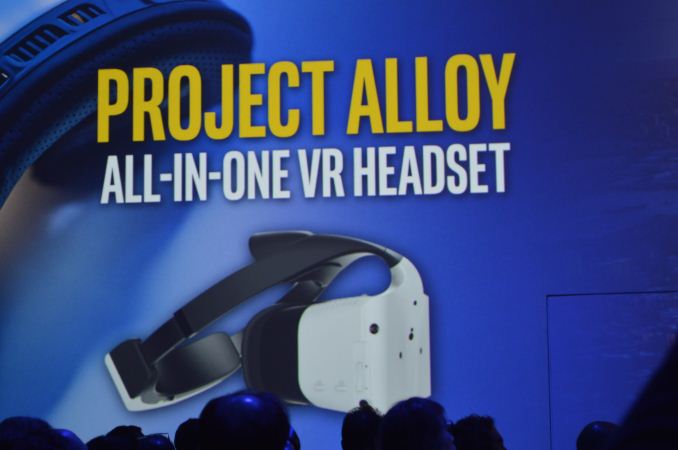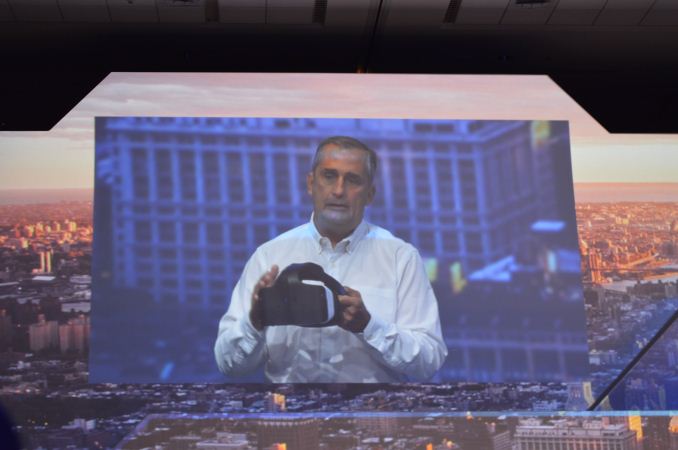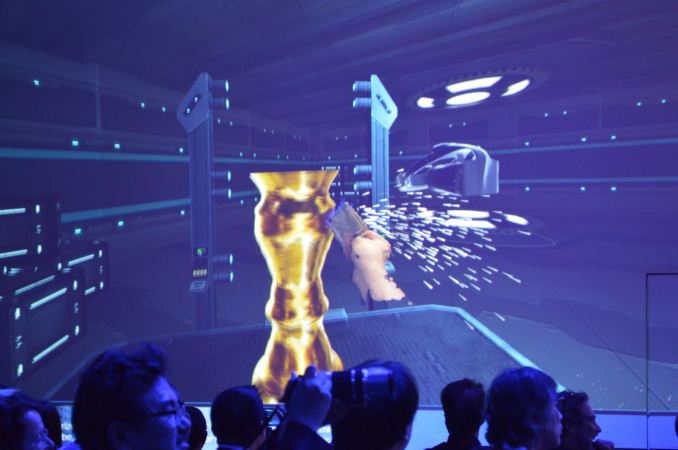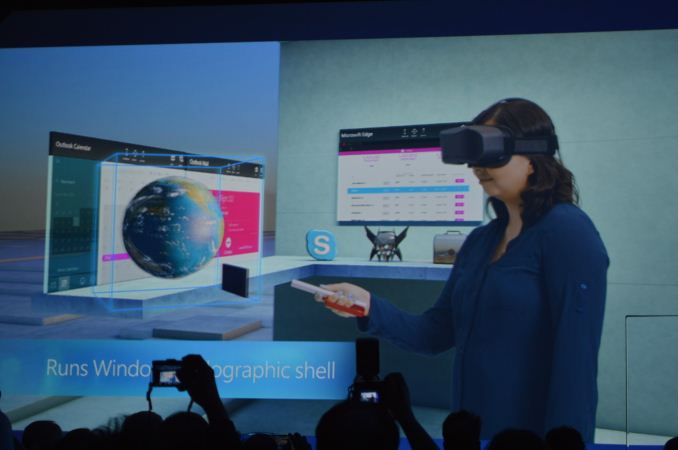Intel Announces Project Alloy: Untethered Augmented Reality in a VR Headset with RealSense
by Dr. Ian Cutress on August 16, 2016 7:55 PM EST
During the Keynote today at IDF, Intel showed off the next play into the Virtual Reality design space. In an interesting twist, their new Project Alloy headset was demonstrated on stage and marketed as a fully untethered VR device that uses dual RealSense cameras to monitor location and position of objects around the user. The headset stills needs a PC for data transmission, such as the Skull Canyon NUC with Iris Pro graphics, but the idea to have a headset without wires is interesting but offers up a number of questions. On top of this, the Real Sense cameras will have full five-finger recognition, allowing the software to adjust the appearance of the users hands or other figures as appropriate (this is where the Augmented Reality comes in).
Intel mentioned that the headset has good weight distribution, as well as an SoC inside for the processing. There was no indication as to the power consumption of that SoC, but I can imagine it being under 10W otherwise it would heat up the users face over time. The back of the headset also has a compartment, which I would assume is battery, which gives another question on the battery life of such a headset.
The VR + AR concept is being marketed as ‘mixed reality’ – the ability to use your hands in a VR environment which also adjusts the visuals of your hands based on what is happening in the scene. In the demo on stage, Intel showed a hand turning into a skeleton hand when placed in front of an X-Ray scanner in the scene. There was also discussion that this sort of mixed reality (MR) allows full roaming capabilities that mean a user won’t easily bump into objects around their home (or walls).
The demo was also projected onto a large screen, and it was clear this is still a prototype as we could see dropped frames. It was mentioned that Holo-Lens used Cherry Trail, and this is more powerful. Another element of use was a mix of 2D/3D environments, such as the eponymous ‘unlimited desktop’ for working and consuming content. The use of RealSense will be similar to at least one other headset with an external camera, but the rendered video on screen showed a person manipulating 2D interfaces projected onto walls with a remote control.
Project Alloy will require a Windows PC with Windows Holographic Platform, which will come to Windows 10 PCs next year as part of the regular updates. V1 of the device will be available to partners in December, and the hardware will be open sourced in the second half of 2017. The RealSense APIs will be opened up as well. Chances are we will see more demos this time next year.














20 Comments
View All Comments
SeannyB - Wednesday, August 17, 2016 - link
If it's sending wireless video to the unit with resolution, frame rate and latency fit for VR, that's impressive.nagi603 - Wednesday, August 17, 2016 - link
One of the main problems with the HTC Vive and Oculus Rift is that they have massive cable dongles leading to the PC. It is ungainly until the user develops a sense for moving it away / not tripping up on it, and it does get around the problem of battery life this unit might have.JKflipflop98 - Wednesday, August 17, 2016 - link
Nice that BK took a break from destroying Intel long enough to actually announce something that will excite people.JoeyJoJo123 - Wednesday, August 17, 2016 - link
So when are VR headsets going to be designed so that you don't look like a total dweeb to other people?sadsteve - Wednesday, August 17, 2016 - link
I agree. Call me when the headset is comparable to a pair sunglasses.BrokenCrayons - Wednesday, August 17, 2016 - link
It will probably take the technology a long time before it becomes portable enough to blend into someone's normal attire. If not that, society will likely bend to accept such equipment as status quo despite it looking ungainly and awkward. But that'll only happen if VR goes mainstream. It hasn't yet by any stretch of the imagination and there are a lot of barriers to widespread adoption. We're closer than we've ever been to reaching the point where VR actually becomes commonplace, but this iteration probably won't find enough buyers to give companies an incentive to go beyond a couple of primitive iterations of the current tech before shelving them again.theuglyman0war - Wednesday, September 14, 2016 - link
It will probably happen about the same time other technologies are looked upon favorably...Like when yer girlfriend finds you on date night instead on the couch with the xbox instead. Wow what an enthusiastic acceptance! Probably give the same answer to any disapproval to HMD fashion gaffe...
There's the door...
Please dont trip over my tether on the way out,
sorten - Wednesday, August 17, 2016 - link
I don't feel that bringing your hands into the VR environment qualifies it as AR. When I think AR I expect to be able to interact with and see the real environment. But "mixed reality" sounds marketable.sorten - Wednesday, August 17, 2016 - link
That said, I like what Intel has created.James Ackerman - Monday, January 9, 2017 - link
Excellent review. This is actually great. It'll be an amazing addition to virtual reality world. Seeing your furniture as objects in virtual world will save you and your furniture from damage. I read something similar about various benefits of virtual reality, you can take a look at it at: http://www.techtyche.com/benefits-of-virtual-reali...